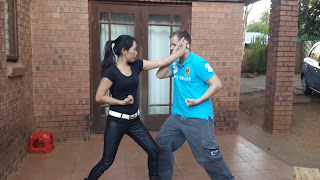Where does this knife hand fit in?- A look at how your sparring affects your fighting
Go to a karate class nowadays and you will find that free sparring is full contact (here in South Africa anyway). Ask the students why and they will most likely tell you that it is the best way to prepare you for an actual self defence situation.
If you look at the techniques they use while sparring you will find that they only use the techniques permitted in tournaments. They'd tell you that it's for safety reasons.
The culture of stopping attacks short of contact during sparring can be traced back to Shaolin Kungfu's early days. A large number of these techniques were known to cause permanent damage. I still remember reading in Wong Kiew Kit's book about the risk of the head of an arm bone being broken off with qin na attacks.
I was not satisfied with calling myself a martial artist if all I had to offer was a series of punches and kicks found in any other style- and a way of fighting which is already known and predictable.
We can't deny it, but many assailants out there also know how to punch.
Experimenting with those forbidden blows like the knife hand to the carotid, the phoenix eye fist to the ribs and so forth was easy enough by myself. Perfecting the timing and range with an actual person, though, was another thing entirely. I don't think anyone wants to leave a class with a missing collarbone or so.
The compromise I have made is that free sparring was to be light to full contact on safe areas like the area between the neck and the pelvis. Throws are to be controlled and areas like the neck, eyes, kidneys and collarbone are not to be attacked with full force. The result was that- instead of one-two punches and gyakuzukis combinations like the one shown in the photos above emerged.
The ability to counter a punch with a throw also got developed.
If you are practicing a martial art style you can do this simple test. Train by yourself and imagine yourself being attacked outside of competition context by somebody who wants to leave you broken and humiliated. Okay- you can imagine him trying to kill you as well. Attack your imaginary opponent as you would in real life. Now- when you are done and can think again- take note of which techniques showed up by themselves. I am sure you know why certain moves just appear by themselves in a fight.
Now ask yourself- what moves would serve you better if they showed up in your time of need?
The next question, naturally, is what you are going to do about it...








Comments
Post a Comment